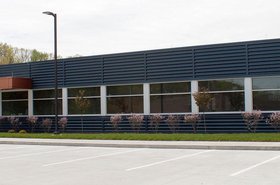In the age of the Fourth Industrial Revolution, manufacturing companies, both large and small, are embarking on an unprecedented transformative journey, reimagining operations and redefining the very limits of what can be achieved.
Disruptive technologies, such as big data, the Internet of Things, artificial intelligence, virtual and augmented reality, and additive manufacturing, are driving innovation and digitalization like never before.
In fact, you could say that in the US, the manufacturing industry is on the brink of making a comeback, and many recent state manufacturing booms are decreasing the sector's foreign dependency while stimulating the economy, stabilizing supply chains and creating new good-paying jobs.
Take Arizona, for example, where 70 percent of projects in the Arizona Commerce Authority pipeline are manufacturing-related. Here, the state has become a high-tech manufacturing destination, and it owes this designation to state and federal investments, along with a strong emphasis on education and building a solid talent pool throughout the Grand Canyon State.
Across the country in Iowa, Youngstown State University joined forces with the University of Northern Iowa and the National Center for Defense Manufacturing and Machining to launch a major Industry 4.0 technology initiative. These are just a few of the steps states are taking to fuel this next (and future) revolution.
Combine these regional examples with today’s novel innovations, and the game for manufacturers is changing. From significantly improving their efficiency, safety and productivity to enabling them to achieve Industry 4.0 goals with large government investments to propelling a skilled talent pool ready to hit the manufacturing floor running, a new dawn is upon this critically important sector.
As a proof point, according to a recent study by Mordor Intelligence, digital transformation in manufacturing is expected to grow from nearly $308 billion in 2023 to more than $733 billion by 2028.
Next-generation manufacturing
As new innovations are being developed at lightning speed, impacting just about every aspect of manufacturing operations, manufacturers are leveraging these emerging technologies to optimize and enhance their equipment, product design, end-user experience, sustainability efforts and more. Two of the major disruptive technologies that are streamlining operations and giving manufacturers a competitive edge are IoT and AI.
IoT (the Internet of Things) has the IT factor and is revolutionizing the manufacturing industry in ways previously unimaginable. By connecting machines, equipment and IT systems to the internet, IoT devices are continuously gathering data, offering valuable insights into production procedures.
The data gathered from IoT devices is then processed and converted into a user-friendly format for managers to make faster and more informed decisions, which leads to more efficiency across operations.
Use cases abound for IoT, including machine health monitoring, predictive maintenance, energy management, supply chain optimization, quality assurance, safety improvements and much more.
The potential for this technology is endless, and its usage across the manufacturing sector is expanding rapidly. According to Fortune Business Insights, the global IoT manufacturing market was valued at nearly $28 billion in 2018 and is projected to reach more than $136 billion by 2026.
Artificial intelligence delivers real advantages and is taking the manufacturing industry (and the world) by storm. What was once an idea only seen in science-fiction movies has now become a reality, and it is benefiting manufacturers significantly.
For example, manufacturers are improving efficiencies with the help of autonomous robots capable of learning multiple tasks, detecting and avoiding obstacles, and lifting heavy objects to make humans’ jobs easier.
Industrial companies are also using AI, along with IoT, to better understand complicated machinery or processes through digital twins. By creating a virtual model of a physical object, teams can monitor performance and make adjustments for continuous improvement.
Some manufacturers are also relying on AI to analyze consumer buying patterns to predict when to ramp up production and how to prevent inventory and supply chain challenges better. These incredible breakthroughs are only the beginning.
According to IIOT World, 81 percent of companies believe AI produces better results. What’s more, the market for AI in manufacturing is estimated to reach nearly $54 billion by 2030 with an exceptional compound annual growth rate of 47 percent, according to Market Research Future.
Other technologies to keep an eye out for include augmented reality and 3D printing, which can help manufacturers design realistic models and virtual prototypes of products, machinery and more.
Digital optimization goes beyond adopting new tech
As manufacturers embrace this new dawn and digital optimization, it’s clear that it goes far beyond simply “plugging in” new solutions. Fundamentally, manufacturers are evolving into digital businesses where just about every aspect of their business is going through some sort of digital transformation.
According to Statista, top targets for digitalization span a wide array of areas, including digital services, ecommerce, customer portals and data analytics. It’s a new way of operating and thinking – and a metamorphosis of this magnitude calls for a rock-solid, comprehensive digital optimization strategy that includes thorough infrastructure assessments, including the right data center partner to support it.
An effective digitalization plan ensures that the current IT infrastructure, tools and teams are equipped to scale as business expands and more new technologies emerge. It also enables manufacturers to remain productive and profitable throughout the transition.
But before embarking on this journey or accelerating to new heights, manufacturers are taking a closer look at their IT infrastructure and data centers (on-prem or colocated) to solidify key asset gaps and determine if systems that need to be optimized should be replaced or moved to the edge or cloud. However, this is risky business.
Going digital and adopting multiple new technologies comes with unforeseen risks. As manufacturers turn to identify potential vulnerabilities in their IT networks and data center facilities, having the right IT partner in place is essential.
Nothing ventured, nothing gained
The adoption of AI, IoT and other emerging technologies in the manufacturing sector ultimately holds the key to the future, especially as more and more manufacturing plants are developed and expanded nationally.
Upskilling talent and educating the next generation on the capabilities and power of these technologies is non-negotiable, and even though there is still a talent and skills shortage, regions are stepping up to the plate to knock it out of the park as we head into the future.
If manufacturers are not venturing in this direction, they will be obsolete.
The future of manufacturing is bright
For more reassurance that this industry is headed for a comeback and breaking away from foreign dependency, in Boise, Idaho, where I sit at a data center penning this piece, Micron officially started constructing the first memory chip manufacturing facility in the US in 20 years. With it comes 17,000 jobs.
This manufacturing metamorphosis is what will help bolster the US economy, and data centers will play a starring role in bridging the gap between the past and the AI-powered manufacturing sector of the future. And the future is bright.
More on Involta
-

Sponsored Involta launches Enterprise Edge Broadcast with expert-led panels and virtual tour of Akron facilities
In partnership with Datacenter Dynamics, Involta delivers an exclusive look at its Midwest Edge data centers and the critical enterprise Edge market
-

Involta expands data center in Independence, Ohio
Cleveland suburb facility gets an extra 14,000 square feet and 1MW
-

Carlyle Group to buy data center company Involta
US services and data center company goes to finance giant

